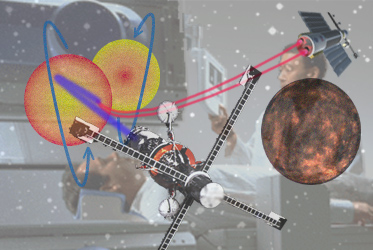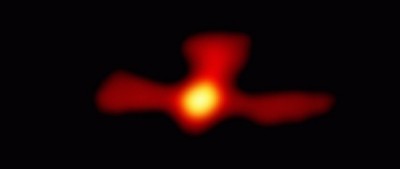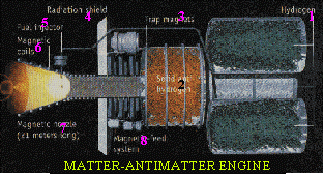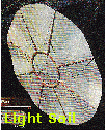
What Exactly is Antimatter?


A Galactic Cloud of antimatter
Antimatter is matter with a charge opposite to that of what we think of as normal matter. Each particle of matter has a corresponding "antiparticle." The electron's opposite is called the positron, while those of the neutron and the proton are called antineutrons and antiprotons. Antiparticles act much the same as ordinary particles. Each has the same mass as their counterparts, but the charge is opposite. Antiatoms can be formed by these antiparticles, just as atoms are made from neutrons, protons and electrons. Besides the charge, the only other major difference is that antimatter and regular matter decay at slightly different rates.
Power
The most interesting part about these opposite particles is what happens when two come into contact with each other. For example if an electron and a positron were to touch both would be totally annihilated leaving only energy. The amount of energy given off is given by Einstein's formula e=mc2, where e is the energy, m is the mass and c is the speed of light (3.0 x 108 m/sec). For instance, if a paper clip (about 1 gram in mass) collided with an antipaperclip the energy produced would be 1.8 x 1014 Joules. In comparison, it takes about 3 x 109 Joules to power a 100 Watt light bulb for a year. In other words you'd have enough energy to power approximately 60,000 100 Watt light bulbs for a year.
What a Great Idea!
If you're wondering why we don't completely convert to antimatter as the world's energy source, it's because the only way we know of to create antimatter is to start with energy and convert it to antimatter. This process is quite inefficient. Another possibility would be to find a source of naturally occurring antimatter. It likely does exist, but somewhere VERY far away. Another problem would be how to store the energy after the reaction. The energy produced in matter-antimatter reactions is in the form of gamma rays. The problem with this is that although there is no inherent radioactivity in the matter or antimatter, anything that comes into contact with the reaction will eventually become radioactive. There is no waste, but there is still the problem of what to do with an old power plant, which has become radioactive over the years.
How can we get Antimatter
Where has all the antimatter gone? One theory says that in the beginning, at the time of the Big Bang there were almost equal amounts of matter and antimatter, with a slight predominance of matter. The excess matter after the big annihilation is the universe as we know it. A second theory says that, also at the time of the Big Bang, there were equal amounts of matter and antimatter, but the antimatter may have migrated to a different part of the universe or perhaps to another universe entirely. Just this last April a fountain of antimatter was discovered spewing more than 17,400 trillion miles into space from the center of our galaxy, the Milky Way. Antimatter cannot be directly detected in space, but when it comes into contact with ordinary matter the gamma rays produced when the two annihilate each other can be. This radiation is what NASA's Compton Gamma Ray Observer, which was launched six years ago to study gamma rays, detected.

Is an engine like this possible
Now one must one must consider energy consumption. For a spacecraft such as the real Voyager, to travel to Proxima Centurai in approximately 10 years, it would have to travel at nearly half the speed of light. According to Einstein's equation, E=mc², as an object approaches the speed of light, its mass increases. With this in mind, the Voyager's mass would become 1½ times greater than it originally was. Not only would it take an enormous amount of energy to travel that far, but for it to travel at half the speed of light, with 1½ times more mass, would take an even greater amount of energy. So much in fact, just to bringing it up to half the speed of light would require a month's worth of all the energy produced by humans.
What is possible now?
But what kind
of energy are you supposed to use? One kind is fission, but that does
not have enough energy. A light sail is another possibility and then
you have antimatter, or fusion. When antimatter comes into contact
with normal matter, both masses are completely converted into energy.
The annihilation process has the highest energy density known. As a
result of this reaction, it would release charges particles (gamma
rays and pions) which could then be directed out the back of a
spacecraft for thrust using magnetic "nozzels". This idea
sounds simple , but there is a catch. Currently, we are only able to
make enough antimatter for medical purposes, such as imaging and
destroying cancer tumors, and scientific research. But to power an
engine is another story. A pure antimatter engine would require
thousands of tons of antimatter and matter, the size of the
Washington Monument. Luckily, teams such as the one led by physicist,
Gerald Smith, at  Pennsylvania
State University, are trying to attack this problem and that of
being able to store it. Small amounts are easy to store in tiny
magnetic traps, so that the charged particles do no annihilate the
containment walls. Now, they are developing containment units to
house larger amounts. Another catch is the fact the fusion occurs at
tremendous pressure and temperature, like that at the heart of stars
like our sun. At 1.5 million degrees Celsius is when "low"
temperature fusion starts. Gerald Smith's team is also working on that.
Pennsylvania
State University, are trying to attack this problem and that of
being able to store it. Small amounts are easy to store in tiny
magnetic traps, so that the charged particles do no annihilate the
containment walls. Now, they are developing containment units to
house larger amounts. Another catch is the fact the fusion occurs at
tremendous pressure and temperature, like that at the heart of stars
like our sun. At 1.5 million degrees Celsius is when "low"
temperature fusion starts. Gerald Smith's team is also working on that.
Taking all of these factors into consideration, approches such as light sails seem more effective and promising than the antimatter or fusion engines. Using a light sail (solar powered), it would provide a cleaner and closer way to travel into interstellar space. Until all of these problems can be solved, and fast efficient ways to make antimatter are developed, the role of antimatter in space travel will still be a dream.